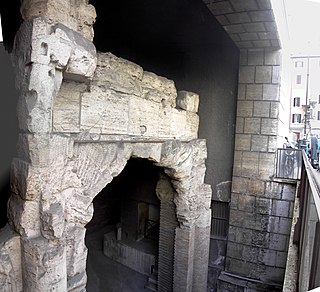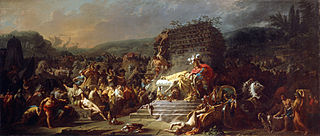
Actium or Aktion was a town on a promontory in ancient Acarnania at the entrance of the Ambraciot Gulf, off which Octavian gained his celebrated victory, the Battle of Actium, over Antony and Cleopatra, on September 2, 31 BCE.

The Battle of Actium was a naval battle fought between Octavian's maritime fleet, led by Marcus Agrippa, and the combined fleets of both Mark Antony and Cleopatra VII Philopator. The battle took place on 2 September 31 BC in the Ionian Sea, near the former Roman colony of Actium, Greece, and was the climax of over a decade of rivalry between Octavian and Antony.

Acarnania is a region of west-central Greece that lies along the Ionian Sea, west of Aetolia, with the Achelous River for a boundary, and north of the gulf of Calydon, which is the entrance to the Gulf of Corinth. Today it forms the western part of the regional unit of Aetolia-Acarnania. The capital and principal city in ancient times was Stratos. The north side of Acarnania of the Corinthian Gulf was considered part of the region of Epirus.

The Pythian Games were one of the four Panhellenic Games of Ancient Greece. They were held in honour of Apollo at his sanctuary in Delphi every four years, two years after the Olympic Games, and between each Nemean and Isthmian Games. The Pythian Games were founded sometime in the 6th century BC. In legend they were started by Apollo after he killed Python and set up the oracle at Delphi. They continued until the 4th century AD.

Nicopolis or Actia Nicopolis was the capital city of the Roman province of Epirus Vetus. It is located near Preveza, Greece. The city was founded in 29 BC by Octavian in commemoration of his victory in 31 BC over Antony and Cleopatra at the Battle of Actium nearby.

Calydon was a Greek city in ancient Aetolia, situated on the west bank of the river Evenus, 7.5 Roman miles from the sea. Its name is most famous today for the Calydonian boar that had to be overcome by heroes of the Olympian age.

Venatio was a type of entertainment in Roman amphitheaters involving the hunting and killing of wild animals.
Astylos of Croton or Astylus of Croton was an ancient athlete who competed in three successive Olympic Games. In 488 and 484 BC he won the stadion and diaulos; in 480 BC he won the stadion, diaulos, and hoplitodromos. Astylos originally represented Croton, but later raced on behalf of Syracuse, according to Pausanias to please Hiero, brother of the tyrant of Syracuse. David Young suggests that Astylos' change of allegiance was solely economically motivated, arguing that Hiero "simply bought Astylos' services".

Archelaus was a Roman client prince and the last king of Cappadocia. He was also husband of Pythodorida, Queen regnant of Pontus.

The War of Actium was the last civil war of the Roman Republic, fought between Mark Antony and Octavian. In 32 BC, Octavian convinced the Roman Senate to declare war on the Egyptian queen Cleopatra. Her lover and ally Mark Antony, who was Octavian's rival, gave his support for her cause. Forty percent of the Roman Senate, together with both consuls, left Rome to join the war on Antony's side. After a decisive victory for Octavian at the Battle of Actium, Cleopatra and Antony withdrew to Alexandria, where Octavian besieged the city until both Antony and Cleopatra were forced to commit suicide.

The music of ancient Rome was a part of Roman culture from the earliest of times. Songs (carmen) were an integral part of almost every social occasion. The Secular Ode of Horace, for instance, was commissioned by Augustus and performed by a mixed children's choir at the Secular Games in 17 BC. Music was customary at funerals, and the tibia, a woodwind instrument, was played at sacrifices to ward off ill influences. Under the influence of ancient Greek theory, music was thought to reflect the orderliness of the cosmos, and was associated particularly with mathematics and knowledge.

The Temple of Apollo Palatinus, sometimes called the Temple of Actian Apollo, was a temple of the god Apollo in Rome, constructed on the Palatine Hill on the initiative of Augustus between 36 and 28 BCE. It was the first temple to Apollo within the city's ceremonial boundaries, and the second of four temples constructed by Augustus. According to tradition, the site for the temple was chosen when it was struck by lightning, which was interpreted as a divine portent. Augustan writers situated the temple next to Augustus's personal residence, which has been controversially identified as the structure known as the domus Augusti.

The Archaeological Museum of Nicopolis is a museum in Nicopolis, in the Preveza regional unit in northwestern Greece.

The ancient Olympic Games were a series of athletic competitions among representatives of city-states and were one of the Panhellenic Games of Ancient Greece. They were held at the Panhellenic religious sanctuary of Olympia, in honor of Zeus, and the Greeks gave them a mythological origin. The originating Olympic Games are traditionally dated to 776 BC. The games were held every four years, or Olympiad, which became a unit of time in historical chronologies. They continued to be celebrated when Greece came under Roman rule in the 2nd century BC. Their last recorded celebration was in AD 393, under the emperor Theodosius I, but archaeological evidence indicates that some games were still held after this date. The games likely came to an end under Theodosius II, possibly in connection with a fire that burned down the temple of the Olympian Zeus during his reign.

The Stadium of Domitian, also known as the Circus Agonalis, was located to the north of the Campus Martius in Rome, Italy. The Stadium was commissioned around AD 80 by Emperor Titus Flavius Domitianus as a gift to the people of Rome and was used almost entirely for athletic contests. In Christian tradition, Agnes of Rome was martyred there.
In ancient Roman culture, infamia was a loss of legal or social standing. Infamia, a Roman legal term, excluded Roman citizens from legal protections. This official exclusion was imposed by a censor or praetor. During the Republic and Principate, infamia damaged one's esteem or reputation. A person who suffered infamia was an infamis.
In Greek antiquity, athletic festivals under the name of "Olympic games", named in imitation of the original Olympic games at Olympia, were held in various places all over the Greek world. Some of these are only known to us by inscriptions and coins; but others, as the Olympic festival at Antioch, obtained great celebrity. After these Olympic festivals had been established in several places, the great Olympic festival itself was sometimes designated in inscriptions by the addition of Pisa.
The geographical region of ancient Nubia covers the area from the First Cataract at Aswan in the north, to the Blue and White Niles at Khartoum in the south, and adjacent deserts. The region includes the Nile Valley of lower Egypt and nowadays Sudan. The earliest history of Nubia dates to the Paleolithic period, and the civilization of ancient Nubia developed alongside ancient Egypt on the Nile valley. Both Egypt and Nubia are characterized by their distinct cultural identities and had lots of interactions—military, political, and commercial—throughout history. Prior to Roman contact, Kush had trade relations with Ptolemaic Egypt. The early interaction between Rome and the kingdom of Kush in Nubia was full of tensions and conflicts before Caesar Augustus established a peace treaty with Kush. Nubia thereby flourished for nearly three centuries through trade with Roman Egypt. Archaeological excavations and written accounts by Classical authors such as Strabo, Pliny the Elder, and Diodorus are important sources of information about Roman relations with Nubia.

In epic poetry, athletics are used as literary tools to accentuate the themes of the epic, to advance the plot of the epic, and to provide a general historical context to the epic. Epic poetry emphasizes the cultural values and traditions of the time in long narratives about heroes and gods. The word "athletic" is derived from the Greek word athlos, which means a contest for a prize. Athletics appear in some of the most famous examples of Greek and Roman epic poetry including Homer's Iliad and Odyssey, and Virgil's Aeneid.














